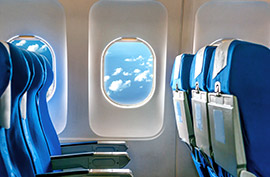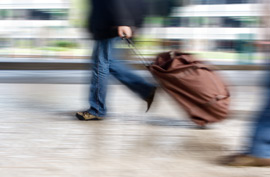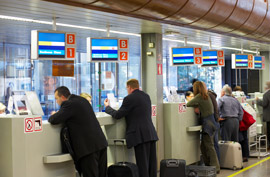 We've all been there -- the small child kicking the back of your seat, the lack of legroom, the war over the armrest. While there's no fail-safe way to guarantee that aisle seat in the exit row near the front of the plane with no one sitting next to you, we have some tactics that will help. Check out our tips for getting the best seat on the plane -- and then share yours in the comments below!
We've all been there -- the small child kicking the back of your seat, the lack of legroom, the war over the armrest. While there's no fail-safe way to guarantee that aisle seat in the exit row near the front of the plane with no one sitting next to you, we have some tactics that will help. Check out our tips for getting the best seat on the plane -- and then share yours in the comments below!
Exit rows, aisle or window seats, and seats close to the front of the plane are typically considered the best. On a short business trip, you probably want an aisle seat near the front of the plane so you can debark as quickly as possible on arrival. On an overnight flight, you'll want a window seat so you can rest your head. Nervous fliers may want to sit over the wing, where there is less turbulence.
Exit row seats usually offer a bit more legroom, but they're not appropriate if you're traveling as a family. By federal law, no one under 15 may sit in an exit row, and infants are not permitted in the rows immediately behind or in front of an exit row either.
Many fliers also like "bulkhead seats," which are the seats directly behind the physical barriers (such as walls, curtains or screens) that separate different parts of the plane. Because there are no seats in front of you, you won't get stuck with another passenger reclining into your lap -- and you often get some extra legroom as well.
 Tips for Fighting Jet Lag
Tips for Fighting Jet Lag
But be careful: Not all "bulkhead" rows are created equal. On some planes, the first bulkhead row may be cramped and uncomfortable. For more information, go to SeatGuru.com, where you can check out seat maps for nearly every type of plane on every major airline.
Keep an eye on seat pitch, especially if you're tall. This is a measure of how much space there is between a seat and the one immediately behind or in front of it -- so the higher the number, the more legroom you will have. SeatGuru lists both seat pitch and width (when available) for most airlines.
Many passengers are concerned about safety, but unfortunately there's no clear answer about where you should sit in order to fare best in a plane crash. One study suggests that you may have a higher chance of survival during a plane crash if you're seated in the rear of an aircraft. However, another more recent study contradicts those findings, indicating that the safest place to sit is near the front of the plane within five rows of an emergency exit. See How to Survive a Plane Crash for safety tips no matter where you decide to sit.
The middle seat in any row is generally undesirable. Rows near flight attendant areas and restrooms may be noisier and experience more traffic, and seats very close to overhead movie screens can be uncomfortable, or bright if you are trying to sleep. SeatGuru also identifies other potential problems on its seat maps, such as limited recline or reduced seat width.
10 Ways to Get a Better Seat 1. Join a frequent flier program. This is the most reliable tactic you can use. Providing your frequent flier number at the time of reservation goes a long way toward netting you a good seat, especially if you are a loyal, high-ranking member. If you don't already have your seat assignment when you arrive at the airport, present your number at check-in.
1. Join a frequent flier program. This is the most reliable tactic you can use. Providing your frequent flier number at the time of reservation goes a long way toward netting you a good seat, especially if you are a loyal, high-ranking member. If you don't already have your seat assignment when you arrive at the airport, present your number at check-in.
2. Buy your tickets early. The number of seats available for pre-assignment dwindles as the travel date approaches. If you can't buy your tickets at least several weeks in advance, be sure to check in online as soon as possible before your flight to select a seat, or arrive at the airport early if online check-in isn't available.
3. Consider purchasing a better seat. Many airlines now offer economy-class seats with extra legroom for an additional fee. JetBlue's "Even More Space" seats are located in exit rows and have 38 inches of seat pitch (instead of 34 - 36 inches on its regular seats). United offers Economy Plus access to high-ranking frequent fliers and to any travelers who pay the annual fee of $499; this entitles travelers to a few extra inches of seat pitch in the coach cabin. (If any Economy Plus seats are still available at flight time, they can be purchased on a one-time basis.) Additionally, several airlines including Delta, American and others also charge for what they call "preferred seating," but is really just the opportunity to guarantee yourself a window or aisle seat in the front half of the plane.
4. Select your seat when you book. Most airline websites and major booking engines allow you to choose a seat when you purchase your ticket, or to return to your reservation after your initial purchase and make your seat selection later. (In most cases this process is free, but some airlines -- including Allegiant Air and Spirit Airlines -- have added fees to select your seat in advance.) If you don't see a seat online that you like, consider calling the airline and speaking to a live agent; sometimes there's a disparity between what's displayed on a carrier's site and what's actually available.
 Five Foods to Avoid Before Flying
Five Foods to Avoid Before Flying
5. Confirm your seat at check-in. Most airlines allow passengers to check in online 24 hours before their flight departs. At that point you can confirm the seat you've already chosen or even choose a better one.
6. Get to the airport early. If you arrive too late at your gate, you may lose your seat.
7. When in doubt, ask. Once you reach your gate, ask whether any new seats have opened up. If other passengers upgrade to business class or don't show up for the flight, you may get lucky and grab a better assignment.
8. Be specific. If you know exactly which seat you're interested in, it can be easier for agents to get it for you. Instead of asking for an exit row or "a good seat," try asking for "12A" -- you'll be more likely to get what you want (or an acceptable substitute).
 9. Keep the agent informed. If you have a medical condition, let the agent know. Most will do their best to accommodate you.
9. Keep the agent informed. If you have a medical condition, let the agent know. Most will do their best to accommodate you.
10. Kindness counts. Approach agents in a spirit of understanding. They hear complaints and demands all day. Treat them like human beings, and they may surprise you.